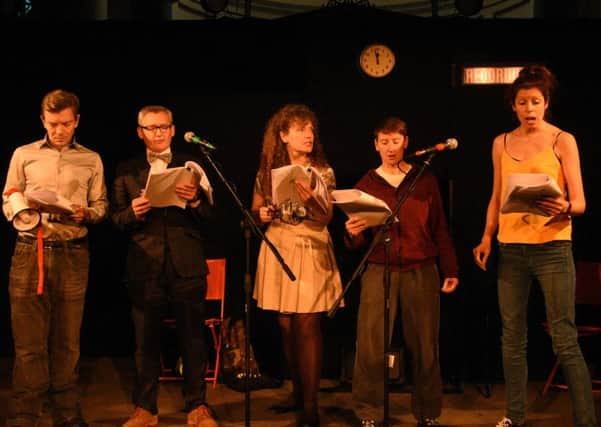Dangerously relevant theatre inspired by an anti-nuclear masterpiece


These days you can’t throw a stick (from a tree which presumably died in a nuclear winter) without hitting a post-apocalyptic or nightmarish, Dystopian vision of the future, in literature, cinema, theatre or TV.
Those doomy Cold War vibes are back with a vengeance, so what better time to rediscover Barry Hine’s grim anti-nuclear masterpiece Threads.
Advertisement
Hide AdAdvertisement
Hide AdCo-produced by the BBC in 1984, the shocking, often harrowing, drama, spliced a dramatised vision of a nuclear conflict and the breakdown of society, with a barrage of cold hard facts and figures, and left no-one in doubt (give or take the odd rabid red-top) of the folly of mutually assured destruction.
Protect and Survive (which enjoyed a seven-day run at St Andrews Church in Hove as part of Brighton Fringe) is inspired by Threads and flits between 2017 and 1984, as a group of actors record a radio play based on the 1980ss Hot Seat exercise, a role-play simulation for a pre and post-nuclear attack on the UK.
The scenarios in the exercise are reminiscent of some key themes and moments in Threads.
We, and the actors taking part in the exercises, are treated to some graphic descriptions of post-nuclear life, including the unimaginable horror of radiation sickness (“You die choking up your insides.”) and the rapid breakdown of society shown through rioting, looting, martial law and much worse besides (“All the threads that hold us together have been severed.”)
Advertisement
Hide AdAdvertisement
Hide AdFor the former children of the Cold War it’s chilling to once more hear the government advice for those attempting to survive a nuclear attack - ‘You can protect yourself and your family.’
Some of those tips are absurd, such as drawing your curtains, which seems scant protection against a thermonuclear blast, and others are just plain horrible, including turfing out any decaying family members from your makeshift domestic shelters.
In fact most of the post-war plans seem pretty ludicrous. Especially the idea that a few council officers and the remnants of a decimated army would be able to rebuild a devastated lawless world. A world ravaged by bubonic plague, cholera, leprosy and widespread radiation poisoning.
The production intercuts the disturbing acted-out scenes of post-nuclear traumas with the comparatively banal lives of the bickering and bantering actors.
Advertisement
Hide AdAdvertisement
Hide AdThis is a smart device and provides relief from the unrelenting misery of the source material.
There are a few good lines along the way (“He’s more of a Brighton hip flask than a hipster”) and the glee with the which the on-stage director reacts to the actors’ bleak trevails (“Nice! Really nice”) strikes a interesting tone.
But the contemporary lives of a small band of thesps, albeit progressively upset thesps, can’t really compete with the horror of the scenarios they’re tackling, nor the increasing fears in the minds of the audience.
This is undoubtedly the play’s biggest strength. In an age of global capitalism few could have imagined that we would be facing such a sudden downturn in world security and an accompanying fear for the future.
Advertisement
Hide AdAdvertisement
Hide AdThe plays ends with a recent warning from the Bulletin of the Atomic Scientists, who concluded we’re closer to nuclear conflict than ever before: “Unchecked climate change, global nuclear weapons modernisations, and outsized nuclear weapons arsenals pose extraordinary and undeniable threats to the continued existence of humanity.”
Protect and Survive is a well-constructed and relevant piece of theatre which deserves more than a nuclear-half life beyond the Fringe. Let’s just we’re all around long enough to see that success.